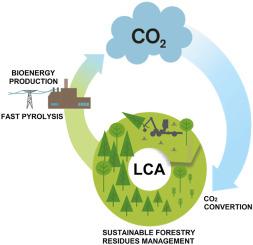Biomass & Bioenergy ( IF 6 ) Pub Date : 2023-04-23 , DOI: 10.1016/j.biombioe.2023.106766 Tamíris Pacheco da Costa, Fionnuala Murphy, Rocio Roldan, Maneesh Kumar Mediboyina, Wenhao Chen, Joseph Sweeney, Sergio Capareda, Nicholas M. Holden

|
The valorisation of forestry residues is gaining interest due to the increasing concerns over climate change and resource scarcity. They are considered important renewable resources of feedstocks to produce energy and other derived bioproducts. However, a holistic technical and environmental analysis of the valorisation of these residues via fast pyrolysis considering different forest residue alternatives and pyrolysis operational conditions is still lacking in the literature. For this reason, this study evaluated the production of bio-oil, synthesis gas and biochar using spruce, pine, and larch residues in three particle ranges and at three pyrolysis temperatures. Based on the experimental results, a virtual model was developed for the most appropriate forestry residues and operational conditions. The experimental process selected for further life cycle assessment (LCA) was the production of bio-oil from larch at a pyrolysis reaction temperature of 300 °C due to its superior bio-oil production. The results in the main impact categories presented better impact parameters than other conversion pathways found in the literature. However, the study likewise established one critical fact from adopting the pyrolysis process: the extensive heat energy requirements. The pyrolysis process is indeed relatively energy-intensive in terms of external heat consumption. However, syngas production could supply the conversion process's heat requirement by concurrent reuse. In addition, the excess energy in the form of biochar could offset the required electrical energy of the process. Hence, for the pyrolysis process to be sustainable, syngas energy must be used on-site, while biochar is used as co-firing fuel for electricity production.
中文翻译:

爱尔兰通过快速热解对林业残留物进行增值的技术和环境评估
由于对气候变化和资源稀缺的担忧日益增加,林业废弃物的增值越来越受到关注。它们被认为是生产能源和其他衍生生物产品的重要可再生原料资源。然而,文献中仍然缺乏通过考虑不同森林废弃物替代品和热解操作条件,通过快速热解对这些残留物进行增值的整体技术和环境分析。出于这个原因,本研究评估了在三个颗粒范围和三个热解温度下使用云杉、松树和落叶松残渣生产生物油、合成气和生物炭。根据实验结果,为最合适的林业残留物和操作条件开发了一个虚拟模型。由于其卓越的生物油产量,选择用于进一步生命周期评估 (LCA) 的实验过程是在 300 °C 的热解反应温度下从落叶松生产生物油。主要影响类别中的结果呈现出比文献中发现的其他转化途径更好的影响参数。然而,该研究同样确定了采用热解过程的一个关键事实:大量的热能需求。就外部热消耗而言,热解过程确实是相对耗能的。然而,合成气生产可以通过同时再利用来满足转化过程的热量需求。此外,生物炭形式的多余能量可以抵消该过程所需的电能。因此,为了使热解过程可持续,


























 京公网安备 11010802027423号
京公网安备 11010802027423号